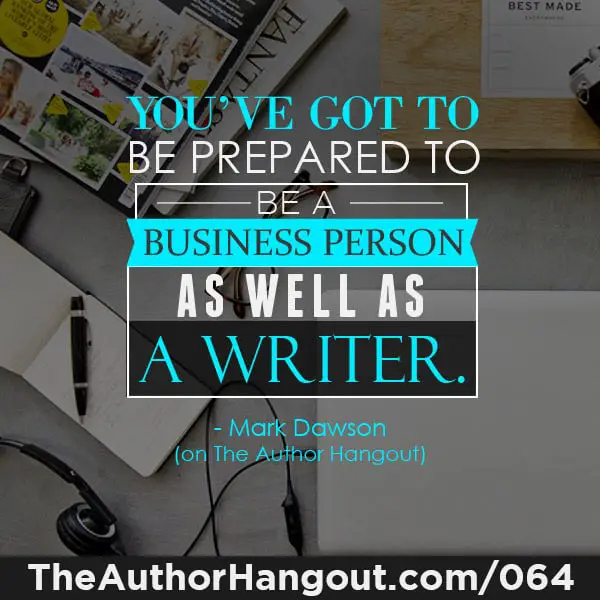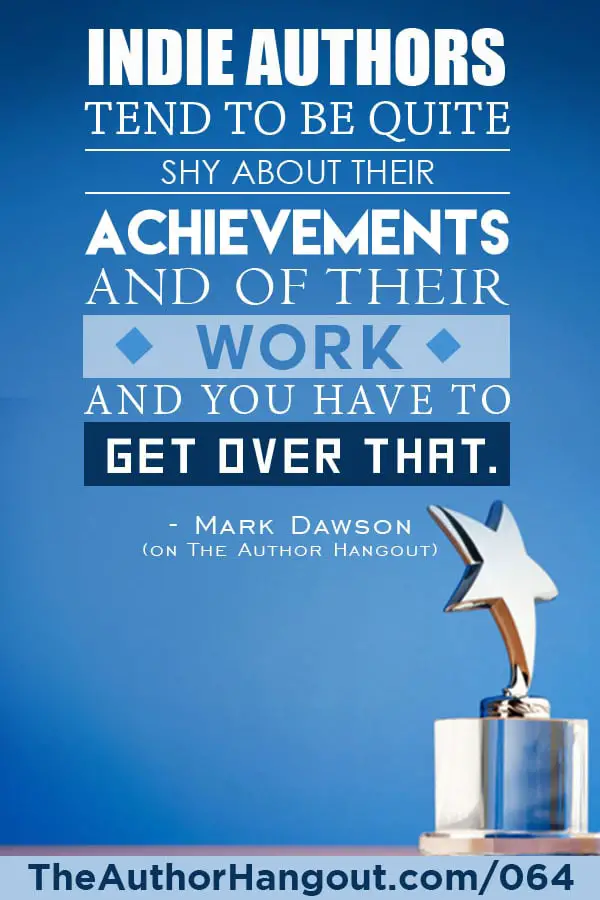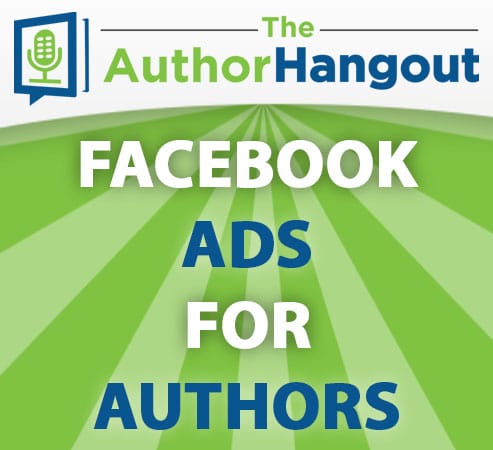Welcome to the 64th episode of The Author Hangout, a podcast designed to help authors, especially self-published and indie authors, with marketing their books and improving their author platform. Authors struggle with various aspects of marketing and we are here to help!
“You’ve got to be prepared to be a business person as well as a writer.”– Mark Dawson
In this episode, we’re going to be talking about how to sell books and build your email list through Facebook Ads for authors. And our guest to do this is none other than Mark Dawson.
Listen to the Show / Podcast
Podcast: Play in new window | Download (36.4MB)
Subscribe: RSS
Episode Resources:

Intro
Today’s episode is a special Thursday edition of ‘The Author Hangout,’ where we tackle a topic that we know that is going to be very tactically important for your career as an author. It is ultimately going to do the one thing that we’re all here for, which is to sell more books. For today’s topic, we’re going to be talking about how to sell books and build your email list through Facbook Ads for authors. And our guest to do this is none other than Mark Dawson. He’s the author of the ‘John Milton’ series, which has sold over 300,000 copies. He’s the creator of ‘Self-Publishing Formula,’ which can be found at http://www.selfpublishingformula.com. And last year alone, Amazon sent him a cool $450,000 for book sales on that platform. Please welcome to ‘The Author Hangout’ Mark Dawson!
What is the background of you becoming an author. Where were you? What were you doing, and how did that come to be?
“I was originally traditionally published in the U.K., so I’m based in the U.K. This would be around ’99, 2000, 2001 – that kind of time. I had a couple of books published by a big U.K. publisher and it was ultimately a bit of a disappointing experience. It was pretty fun: it was great getting an agent and great getting the books accepted for publication – all of that was amazing. And it was fun up until the books were published, pretty much. They were published, they made it into stores, which was very cool… I remember going into stores in my lunch hour, because I was a lawyer at the time, and seeing the books on the shelves, but it was disappointing because they were on the wrong shelves, so they were too low or too high. And they disappeared from the shelves pretty quickly. There was no promotion, no marketing that I could see. And, you know, despite being given a reasonably healthy advance, I would have expected at least some – maybe not an equivalent amount – but some amount to have been spent on getting those books into the… bringing them to the attention of readers, and that didn’t really happen, at least not that I could see, so I stopped writing. The whole thing kind of turned me off of writing for about six or seven years, and it was only when the Kindle came around that I decided that I’d give that a shot because a friend of mine had had some limited success. His books were being sold, and he could see that they were being sold. He was getting emails from readers, which was cool. I never got any kind of correspondence from people who had read my book, and I had always wondered if there was something I was reading. So, I thought, “Well, if he can do it, then I’m going to do it, too.” So I got back down to writing again, and the first self-published book (was produced) probably about three and a half, four years ago now, and every year it’s gotten better and better.”
How in the world did you sell (more than) 300,000 copies of your books?
 Mark talks about what it takes for authors to be big sellers:
Mark talks about what it takes for authors to be big sellers:
““It’s probably 450,000 now. It’s gone up, and they still sell amazingly well. How do I do it? Well, I think kind of the main thing I say is writers these days – and I’m being kind of big-picture level – you’ve got to be prepared to be a business person as well as a writer. Too many writers that I know almost seem to have a disposition that suggests that they don’t want to get involved with commerce and promotion. They tend to be quite shy, often, and they’re not prepared to promote their books, and people who do that, the chances are you’re not going to get a lightning strike – it doesn’t happen very often. Books don’t just appear on Amazon from out of nowhere and sell. You’ve got to be there to push them. No one else is going to do it. You don’t have a publisher – you are your publisher – so you’ve got to be prepared to do that. I realized that reasonably quickly, and then I was a little slow to get this started, but you have to have a mailing list. It’s absolutely critical to own the means of communication with your readers because I love Amazon – they’ve changed my life. And I love Apple, and I love Kobo, and I love Barnes & Noble. I don’t love Google. Google, we can maybe talk about later (Laughs). But you need to own those customer details because Amazon is not going to tell me who my customers are; that’s confidential information that won’t be disclosed. So, I need to have that myself because Jeff Bezos might wake up tomorrow and stroke his chin and think, “Ah, I don’t know – 70% seems a bit high. I’m going to change it to 50%.” If that happens, then maybe, strategically, it makes more sense for me to direct my readers to Apple, who might offer me 70%. Or vice-versa. Anything can happen, but the bottom line is I want to own that information. You know, there’s that concept of digital sharecropping that you’re growing your harvest on someone else’s land. I don’t want to do that. I always want to be in a position where I have my readers’ information, and I can contact them directly. So that’s been a big focus, and because I’m fairly laser focused on growing the list, amplifying it with Facebook Ads, I think I’ve gone through about 30,000 now on my list. And that enables me to do some pretty amazing things with book launches and advance teams and kind of powerful stuff that enables you to get a leg up on your rivals.”
How did you get started with Facebook Ads?
Mark discusses how he started using ads on Facebook to build his email list.
“I was losing money. I was selling some books, but the problem was that the ads were too expensive when compared to the limited financial recompense that Amazon was providing me with, so $1.50 coming back is probably not enough to sustain a proper Facebook campaign, so I looked at that, and although it was a bit of a bust, I could have twitched enough of the kimono aside to see that this was potentially an extremely powerful advertising platform. So, I decided I would try and send some traffic to a landing page that I set up with the purpose of collecting email addresses as new subscribers, so I give away four books as what I call a “Starter Library,” and in exchange for that, potential readers provide me with an email address, so that’s the exchange. So I started to direct traffic from Facebook, targeting fans of authors in my genre, so Lee Child was the first, I think, I targeted, then Vince Flynn, James Patterson, Baldacci, all these guys. So I target their fans, offer them something I thought was very good value, a pretty cool deal. They’d go to my landing page. They’d fill out their details. That would go into MailChimp, and I’d have another subscriber. And that immediately demonstrated enormous potential. And I think I ran that campaign for about – I’m going to guess the numbers here – so it was between six weeks and two months, and added two or three thousand new subscribers, maybe a touch more than that.”
What do you give away to entice people to become subscribers?
Mark explains the value that he offers new subscribers.
“I give away two novellas and two novels. So the first kind of free introductory novella in the ‘Milton’ series, and then the first novel, The Cleaner, and then kind of a similar deal for my ‘Soho Noir’ series, and that’s not completely altruistic – it’s a great deal, I mean, those books alone, you’d be looking at, they save you about $15 or something like that, so there is some value there – but from my perspective, those are funnel-starter books. I survey my readers every year. I do a big Survey Monkey survey, which is very, very interesting. And I know that my read-through is reasonably high, so once someone has got into the books, they do tend to work their way through the series, and there’s another six books and a novella behind those, the ‘Milton’ books, so from my perspective, I’m very, very happy to give away the novella and the novel, which would cost me maybe six dollars in sales I might potentially have made, maybe. Because by doing that, I’m opening up the possibility that I’ll actually sell, I don’t know, maybe $35 worth of novels following that, plus every time I’ve got a new book to release, I’ve got another hopefully interested reader ready to make the purchase. I’ve demonstrated that with the last book that I launched, just with my mailing list, so before Amazon got involved with “Also boughts” or their own email shoutouts to people in the genre, readers who like the genre, I got Headhunters, which was the most-recent ‘Milton’ book up to 102 in the whole Amazon store, just on the back of my mailing list.”
What does a good Facebook Ad look like?
 Mark talks about the characteristics of a winning ad:
Mark talks about the characteristics of a winning ad:
“You can still serve ads to the right column, but the click-through rate is abysmal for those, so I wouldn’t recommend it. I tend to serve all of my ads into the Newsfeed. And you can do one of two ways. You can either try it and fit into that experience, so you don’t necessarily need a professional image. I’ve had one student took a picture of a palm tree with her cell phone, and that converted quite well, which slightly, counterintuitively, it worked pretty well. The other way around is to try and be very professional. And I tend to go that route, so I get my cover designer to make a colorful image, usually based on my covers that will stand out in the Newsfeed. I write some punchy copy – you have to be prepared to espouse your talents a little bit. You can use reader reviews, that kind of stuff. Also, you have to be truthful if you’re going to be making claims. I might say, for example, “350,000 copies sold worldwide,” “Hollywood option,” you know, “Hollywood is interested,” all of this kind of stuff, all of which is true, but you need to be able to… Indie authors, in particular, tend to be quite shy about being proud of their achievements and of their work, and you have to get over that. So, you put that kind of copy in. There’s other ways to do it, as well, that I’ve seen work, but that’s the way that I would do it. Then you have kind of a punchy headline below the image, maybe a little call to action, and then, you know, you can choose a call-to-action button on Facebook – something like “Download” or “Shop Now,” and that is that. Provided you are getting those right and Facebook lets you split test everything so it’s easy to disqualify copy formulations that don’t work or images that aren’t converting properly. You find a strong ad, then you can look at how best to target it, and, you know, some of the things you can do with that are just ludicrous and amazingly powerful.”
Can you tell us a little about your platform, “SelfPublishingFormula.com”?
“I put a course together; I’ve kind of regretted it almost as soon as I started it because it’s an enormous undertaking, and I completely underestimated, but I put a course together; it’s all video with some downloads. It’s me working with two guys here from a professional video-production company, so it’s high quality. Everything is very carefully put together. What I do is I go through kind of a general overview of how to use Facebook advertising, explaining things like campaigns and ad sets and ads and some of the terminology that comes up. And then there’s a module on using ads for subscriptions, so building your mailing list, and there I touch on things like copy that you can use, automation copy that when people come on to the list. Mailing list hygiene, all that kind of stuff. And then we get to another module, which is dedicated to sales, so how to craft ads that will sell books, how to track those using affiliate tracking. All that kind of stuff. We do some stuff on surveys. Really, it’s quite a bonus. It’s a bit more than just Facebook advertising, and then for this particular launch, because we launched it once before in June, this particular course, we are updating with a bonus module on Twitter advertising, which is becoming quite interesting at the moment, so we’ve spent quite a bit of money testing that, and that’ll be a full module on that. Plus I’m recording right now with things like Facebook’s new “Lead Gen” objective, which is really powerful for mailing list. Facebook Lightball Casting, which I’m doing a bit of. How to interact with your Facebook Page. Lots and lots of stuff, and I think I’ll probably run out of time before I run out of things to talk about (Laughs). It’s all looking great. We had, I think, 455 students the last time we opened. So, it would be nice to get a good number, and again, the response was amazing last time.”
How can people contact you?
“The best place is going to be selfpublishingformula.com.”
Please Leave Us A Review
Just like authors do with their books, we need reviews for our podcast! Reviews for our podcast help other authors to learn about and learn from The Author Hangout. Can you take a moment to leave a review for our podcast? If you don’t know how but are willing to leave a review, please go here to learn how to leave a quick review for our podcast. It will only take a minute, but it will help a lot. Thank you so much!
How To Listen
There are many ways to listen to the show:
- Right here… You can listen to the interview above!
- iTunes… Our podcast is up and running on iTunes! Click here to listen to past episodes and subscribe for free to be notified of all future podcasts!
- Stitcher… If you prefer Stitcher for your podcast listening, you can listen to our podcast here.
Other Episodes
Get caught up on the other episodes of The Author Hangout that you may have missed:
- Ep 145: “Million Dollar Book Business”
- Ep 144: “Network Net Worth”
- Ep 143: “Learning to Hack Learning”
- Ep 142: “Making Of The Perfect Optin”
- Ep 141: “Coaching Breeds Author Success”
- Ep 140: “Gumroad for Authors”
- Ep 139: “Above The Noise”
- Ep 138: “Goal Setting Check-in”
- Ep 137: “Relying On Others”
- Ep 136: “Honest Conversations on Book Marketing”
- Ep 135: “Recognition of Hard Work”
- Ep 134: “Improving Kindle Book Rankings”
- Ep 133: “Making Money Fast?”
- Ep 132: “Book Marketing & Book Launches”
- Ep 131: “Authors Answers: How To Get Book Reviews”
- Ep 130: “Author Answers: Author Street Teams”
- Ep 129: “Author Answers: Using KDP Select or Not”
- Ep 128: “Traffic, Subscribers, and Sales”
- Ep 127: “Book Marketing Tips from Experts (Part 7)”
- Ep 126: “Media Interviews & Book Marketing”
- Ep 125: “Book Marketing Tips from Experts (Part 6)”
- Ep 124: “Goal Setting for Authors”
- Ep 123: “Author Answers: Social Media Engagement”
- Ep 122: “Speaking, Podcasts & Mailing Lists”
- Ep 121: “Authors Answers: DIY Blog Tours”
- Ep 120: “Book Launches & Pay-Per-Click Advertising”
- Ep 119: “Author Answers: Choosing Comparison Titles”
- Ep 118: “Writing as a Career & Audiobooks”
- Ep 117: “Self-Publishing & Book Launches”
- Ep 116: “Podcasting for Book Marketing”
- Ep 115: “Author Answers: Best Marketing Activities”
- Ep 114: “Book Launches & Video Marketing”
- Ep 113: “Writing Faster, Marketing Smarter”
- Ep 112: “Book Marketing Momentum”
- Ep 111: “Building Book Launch Teams”
- Ep 110: “Book Launches and Distribution”
- Ep 109: “Email Lists & Facebook Live”
- Ep 108: “Facebook Ads for Book Marketing”
- Ep 107: “NaNoWriMo, Writing, and Marketing”
- Ep 106: “Book Marketing Success & Failure”
- Ep 105: “Telling Stories & Reaching Readers”
- Ep 104: “Connect With Other Authors”
- Ep 103: “Maximizing Your Book Marketing”
- Ep 102: “Audiobooks and Book Marketing”
- Ep 101: “Author Email Marketing Automation”
- Ep 100: “Looking Back, Looking Forward”
- Ep 099: “Maximizing Book Promotions”
- Ep 098: “Meta Data Is Your Brand”
- Ep 097: “Kindle in Motion & More”
- Ep 086 – How To Create an Irresistible Opt-In Incentive

